Moon’s Move to Morning Sets a Solar Eclipse and Galaxy Season, Pons-Brooks Approaches Jupiter, and Planets Prance at Dawn

This simulated view of the April 8, 2024 solar eclipse from the vantage point of the sun shows the spherical moon’s round shadow cast upon the Earth at 18:16 Greenwich Mean Time (or 2:16 pm EDT). The motion of the moon will cause the shadow to complete its passage in several hours. We never see that unfamiliar hemisphere of the moon from Earth. (Starry Night Pro 8)
Welcome to April, Stargazers!
Here are your Astronomy Skylights for the week of March 31st, 2024 by Chris Vaughan. Feel free to pass this along to your friends and send me your comments, questions, and suggested topics. You can also follow me on Twitter as @astrogeoguy! Unless otherwise noted, all times are expressed in Eastern Time. To subscribe to these emails please click this MailChimp link.
If you’d like me to bring my Digital Starlab portable inflatable planetarium to your school or other daytime or evening event in Bruce, Grey and Simcoe Counties, or deliver a virtual session anywhere, contact me through AstroGeo.ca, and we’ll tour the Universe, or the Earth’s interior, together! My book with John A. Read entitled 110 Things to See With a Telescope is a guide to viewing the deep sky objects in the Messier List – for both beginners and seasoned astronomers. DM me to order a signed copy!
The moon will move into the morning sky this week as it prepares to cross in front of the sun on April 8 – so I’m sharing a ton of information about next Monday’s solar eclipse. The dark, moonless evenings will also be ideal for galaxy viewing and the sight of brightening Comet 12P/Pons-Brooks. Bright Jupiter near Uranus will continue to dominate in early evening, while Mercury heads to the morning sky, where Mars, Venus, and Saturn are shining. Read on for your Skylights!
Solar Eclipse Essentials
Let’s go over some information to prepare everyone for next Monday’s total solar eclipse – or partial eclipse if you aren’t as fortunate.
We’re used to seeing celestial objects rise in the east, cross the sky, and set in the west – all due to Earth’s 24-hour rotation. At the same time, the orbital motion of the moon around Earth is steadily carrying it the opposite direction – from west to east with respect to the distant background stars. The amount it moves is about equal to the moon’s diameter every hour. Over the course of an evening, it’s easy to notice the moon shifting eastward compared to stars located near it in the sky. In the northern hemisphere that draws the stars farther to the moon’s right every hour.
At one point in the moon’s monthly orbit, it must pass between Earth and the sun, becoming invisible from Earth – both due to the sun’s glare and because sunlight isn’t reaching the side of the moon we see – for a day or so. That is the definition of new moon. Two weeks later we always see the full moon fully illuminated all night because it is then opposite to the sun in the sky.
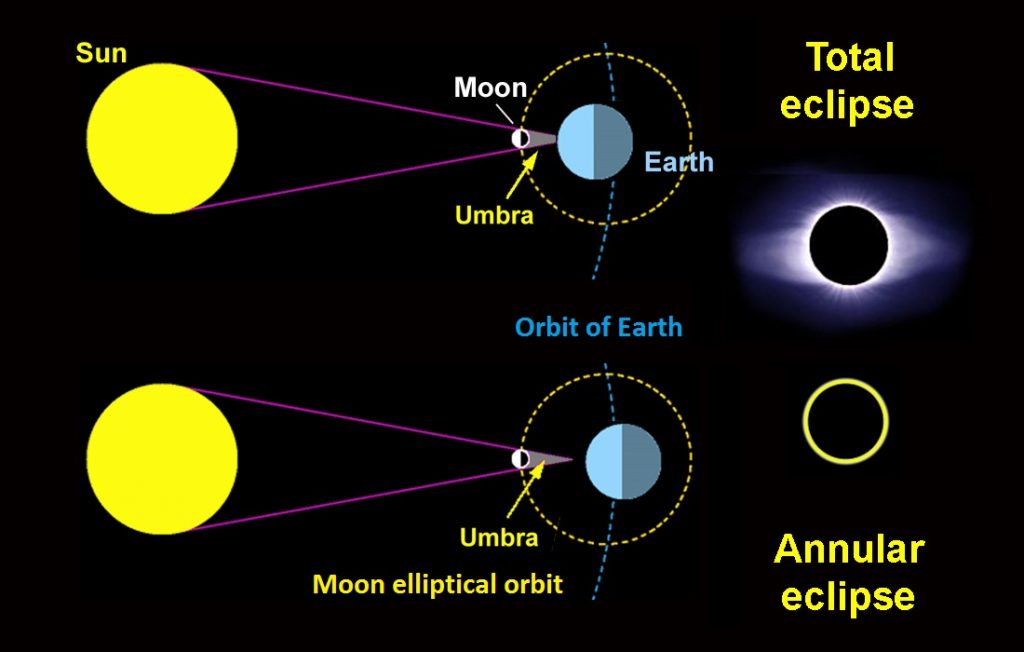
If the sun, Earth, and moon were all orbiting in the same plane (imagine a model of them moving in elliptical tracks affixed to a tabletop), every new moon would temporarily block the sun and cast a circular shadow on the Earth. At every full moon, the Earth would hide the sun from the Moon as it passed through our shadow for a few hours, producing a total lunar eclipse. So why do these events seem to be so rare?
While the objects in the solar system orbit the sun in roughly the same plane, each body’s orbit is tilted by a small angle that carries it sometimes above and sometimes below the solar system’s “tabletop”, like the rising and falling horses on a rotating carousel. The main reason eclipses occur infrequently is because the moon’s orbit is tilted, or inclined, by about 5° from the Earth’s orbital plane.
On infrequent, but predictable occasions, the instances of new moon and full moon occur when the moon is situated at the place where its orbit and the Earth’s orbit intersect, also known as a node. This is the geometry that creates eclipses. The Earth has a much larger diameter than the moon, so an eclipse can still occur when the moon is slightly below or above the node. That is why each eclipse is visible from a particular latitude on the Earth. When the moon is near a node, it is either climbing slightly or descending slightly along the 5° slope. The effect of this is to add a slant to the eclipse track or path on the Earth. The Earth’s constant rotation during the eclipse serves to lengthen the eclipse track. That’s why a given eclipse track changes in both latitude and longitude.
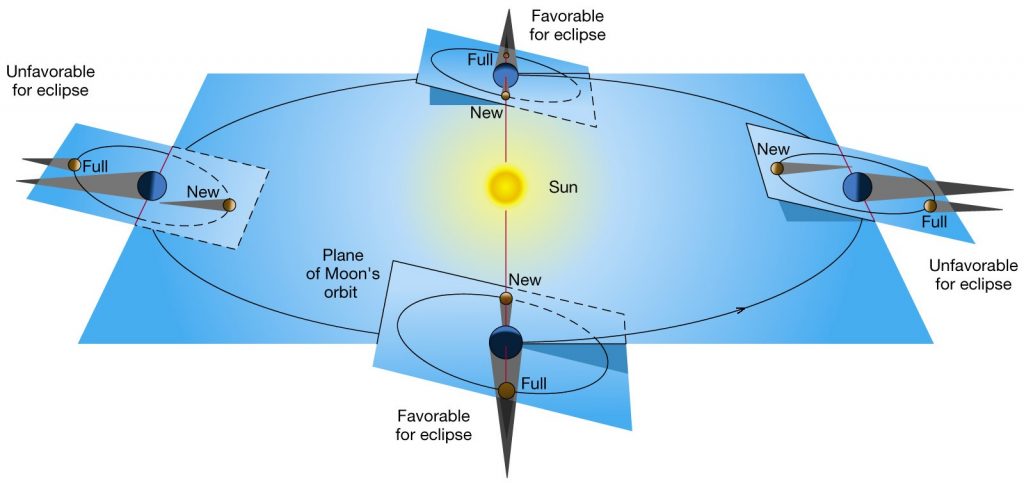
Normally two, but rarely up to five, solar eclipses occur somewhere on Earth every year. A total solar eclipse occurs only about every 18 months. The rest are partial, annular, or hybrid (a mix of both) types. The way the eclipse tracks sweep across the Earth will deliver a total solar eclipse over a given spot on Earth about every 375 years. The solar system moves like clockwork. A sequence of motions called the Saros Cycle repeats eclipses over the same strip of Earth every 18 years, 11 days, and 8 hours – but that extra 8 hours of Earth’s rotation shifts the eclipse visibility east by a third of day’s worth.
By happenstance, and fortunately for us, the size of the sun’s disk and the moon’s disk observed from Earth are almost exactly the same, even though the sun is about 400 times larger! If this were not so, we would not be treated to the splendor of a total solar eclipse.

During a total solar eclipse, the moon’s round shadow sweeps across the Earth faster than the speediest fighter jet, completely blocking the sun for observers along the track of the shadow for only a few minutes. The best eclipses have 250 km wide tracks and many minutes of totality. Along both sides of the track, observers see only part of the sun obscured – the farther from the path of totality, the less of a “bite” is taken out of the sun. This is called a partial solar eclipse.
Because the moon’s orbit is elliptical, it moves closer (perigee) and farther (apogee) from the Earth during every orbit, making the moon subtend a slightly larger and smaller angle in the sky respectively. When the moon is near apogee during a total solar eclipse, it is too small to completely cover the sun’s disk, and we observe an annular solar eclipse. The moon is being pulled into a faster orbit due to the Earth’s tidal bulge rotating ahead of it. That speed is enlarging the moon’s orbit, lifting it farther from Earth, shrinking the moon’s apparent size, and eventually eliminating total eclipses. (A solar eclipse is actually not an eclipse, but an occultation – when one body passes in front of, and obscures, the other. A lunar eclipse is the genuine article, though; the Earth prevents sunlight from reaching the moon.)
Astronomers use the term “contact” to describe the stages of a solar eclipse. First contact is said to occur when the leading edge of the sun and moon first touch. Only after this occurs, will one see the “bite” in the edge of the sun. Fourth (or last) contact occurs at the end of the encounter, at the moment when the two disks separate, i.e., the “bite” disappears.
Total Solar Eclipse of April 8, 2024
The new moon of Monday, April 8, 2024 will generate another Great American Total Solar Eclipse, following the previous one on August 21, 2017.
April 8’s eclipse will occur along a 180 km (112 mile) wide track running from Mexico to the Canadian Maritimes, giving lucky observers with sunny skies and eclipse glasses a chance to see the spectacle in the middle of the day. A Google map of the track is here.

The moon’s umbra will first contact the Earth in the Pacific Ocean north of Bora-Bora, Polynesia at 16:39 UTC or 5:38 am Tahiti Time, though observers there will not see the partially eclipsed sun until it rises half an hour later. The umbra will make landfall over Mazatlan, Mexico at 18:07 or 12:07 pm, giving 4m18s of totality. At that time the sun will be 68° high in the sky.
The eclipse will sweep northeastward across Mexico and then through central Texas. Parts of San Antonio, Austin, Waco, Fort Worth, and all of Dallas will experience totality – the latter for 3m53s. From there the eclipse will cross parts of Oklahoma, Arkansas, Missouri, Kentucky, Indiana, and Ohio – giving Indianapolis and Cleveland a show at 19:06 UTC or 3:07 pm and 19:14 UTC or 3:14 pm EDT, respectively.
The northern edge of the path of totality will touch Canadian soil west of Leamington, Ontario at 3:14 pm EDT. From there, observers along the north shore of Lake Erie can see about two minutes of totality. The centre of the track will pass over downtown Buffalo, New York, and will stretch north to cover all of Niagara Falls, Hamilton, Burlington, and western Oakville. Toronto will experience only 99.8% totality, but observers northeast of Cobourg and those in boats on Lake Ontario can see the total eclipse.
Kingston, Ontario will experience a generous 3m3s of totality at 3:22 pm EDT. Central Montreal will straddle the northern edge of the track, but lucky Sherbrooke, Quebec will see 3m26s of totality. The moon’s shadow will next cross northern Maine, then central New Brunswick and the western half of Prince Edward Island. The eclipse centre line will pass close to Channel-Port aux Basques at 5:09 pm Newfoundland Time and then sweep through central Newfoundland until it reaches the Atlantic at Bonavista, NFLD at 5:15 pm NT. The moon’s shadow will lift off the Earth in the North Atlantic Ocean at 19:53 UTC – a total trip time of 3h14m.
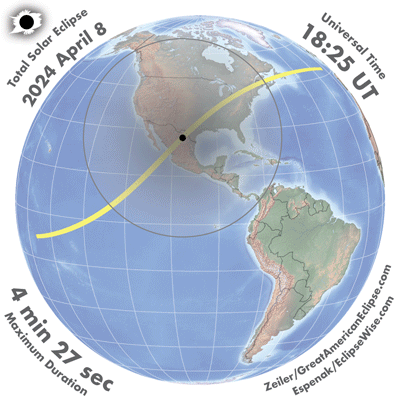
A partial solar eclipse will be visible from Hawaii, across North America (except Alaska), Central America, and the northern edge of South America. This eclipse will occur one day after perigee, generating large tides worldwide and also lengthening totality due to the increased angular size of the moon.
Current versions of the free Stellarium program include a tool that shows the maximum eclipse appearance for any location. Click the Astronomical Calculations Window [F10], and then the Eclipses tab, and then the Calculate Eclipses button at lower right.
Observing the Solar Eclipse
It is NEVER safe to look up at any exposed sun without a proper solar filter. Observers during the few minutes of totality, when none of the sun is visible, may turn their gaze upon the Moon-obscured Sun and see the glorious corona and red solar prominences that rise from the Sun’s photosphere. Outside of totality, part of the Sun’s disk is always exposed, and any amount of unprotected viewing is harmful to your eyes. Sunglasses are NOT enough to protect your eyes. They may make the sunlight dim enough to seem comfortable, but they do not filter out the harmful invisible ultraviolet (UV) and infrared (IR) radiation that damages eye tissue. Your retinas do not have pain receptors that will alert you to the damage you’re doing to them.

Safe methods of observing solar eclipses include wearing special eclipse glasses (commonly inserted into astronomy magazines published prior to major eclipses or handed out by libraries, science centres and museums, and astronomy organizations), #14 or darker welder’s glass, pinhole projection setups, and special telescope filters. NEVER pass unfiltered sunlight through a telescope or binoculars. Damage to vision will be instantaneous, the equipment will likely suffer damage, and there is risk of fire, too. Direct sunlight can also damage your phone or DSLR camera.
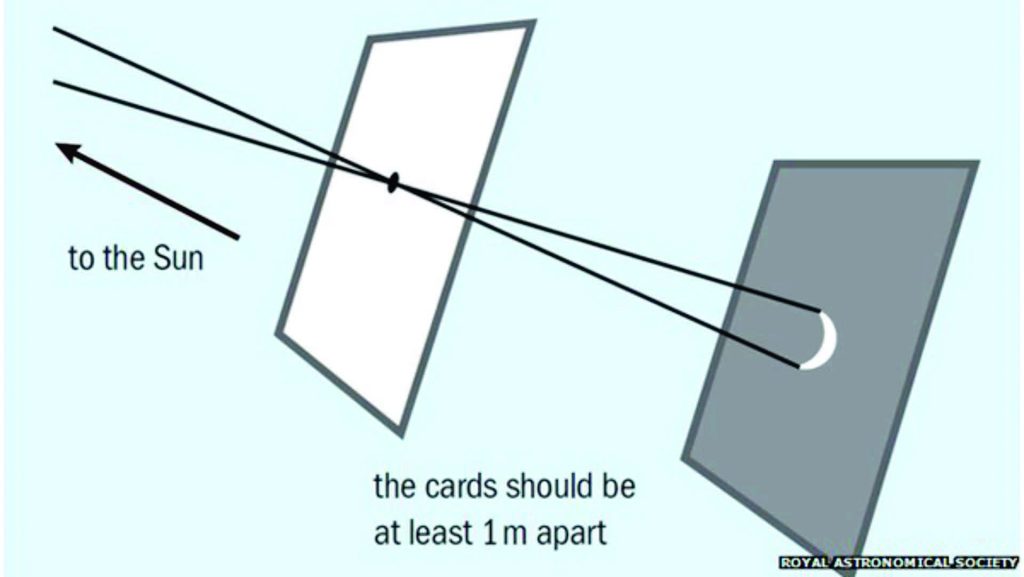
What to Watch For
One of the best ways to enjoy the eclipse – especially for kids – is to project the crescent sun onto the ground or a piece of paper through tiny holes in any object. That can be a piece of cardboard or heavy stock, the holes in a kitchen strainer, and gaps between your crossed fingers or between tree leaves! That draws everybody’s eyes downward. If you have eclipse glasses or viewers, put them over your eyes while looking away from the sun, enjoy your view of the eclipse, and then turn your face away from the sun before removing them. Quality, ISO 12312-2: 2015 certified eclipse glasses, are required. The RASC has a comprehensive eclipse information page at https://rasc.ca/eclipse2024.
Pay attention to your surroundings before the total eclipse starts. Once the moon has covered almost all of the sun, you should notice a significant temperature drop – even for a deep partial eclipse. The birds and animals may quiet down thinking that nightfall has arrived. With your glasses off, look in the direction that the shadow is arriving from (southwest) for a band of darkened sky and land. When only a sliver of the sun remains, the shadows it casts will sharpen weirdly – and you might see ripples on the ground produced by Earth’s air turbulence distorting the line light source of the sun overhead. Put your eclipse glasses back on whenever you want to check on the sun itself.
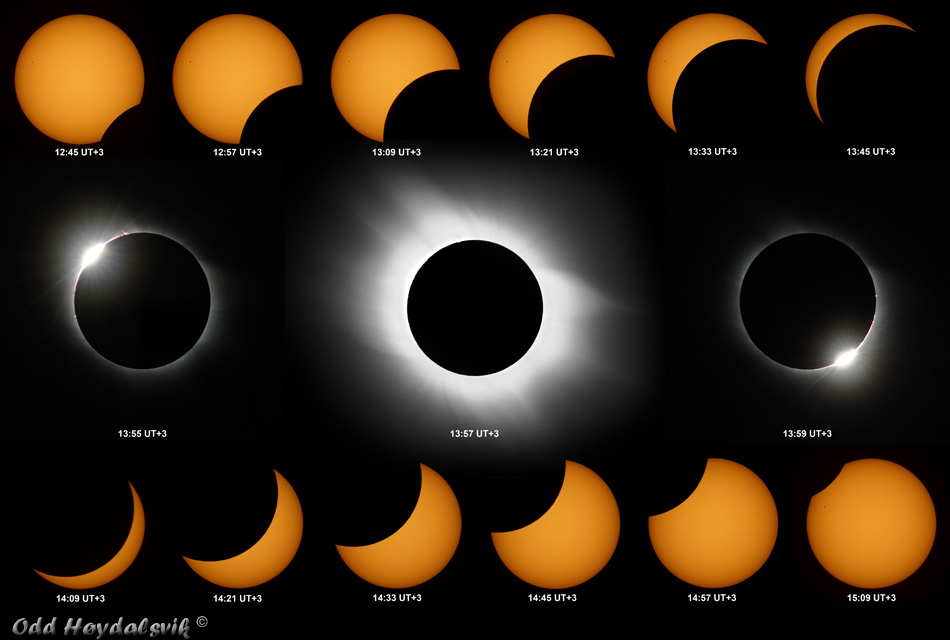
As soon as the moon has completely covered the entire sun, you can remove your glasses and soak in the spectacle. The sun’s corona will stretch in a complex pattern around the inky blackness of the moon – looking like a hole in reality! Every solar eclipse has a unique corona shape. Unaided eyes, binoculars and telescopes can seek out pink or orange spots or loops around the moon’s limb – solar prominences! Use an app with audible cues or have a person watching the clock and calling out to warn of the end of totality. The sun is currently in the active part of its 11-year cycle. That should produce extra eruptions/prominences around the edge of the moon.
Totality brings additional observing opportunities, but you’ll need to work quickly. No bright stars will shine near the eclipsed sun, but bright Venus should be visible some 1.5 fist diameters to the eclipsed sun’s lower right (or 15° WSW). Bright Jupiter will be about three fist diameters to the upper left (or 29° to the celestial ENE) of the eclipsed sun. For a challenge look for Saturn and Mars huddled about two fist diameters to the lower right of Venus.
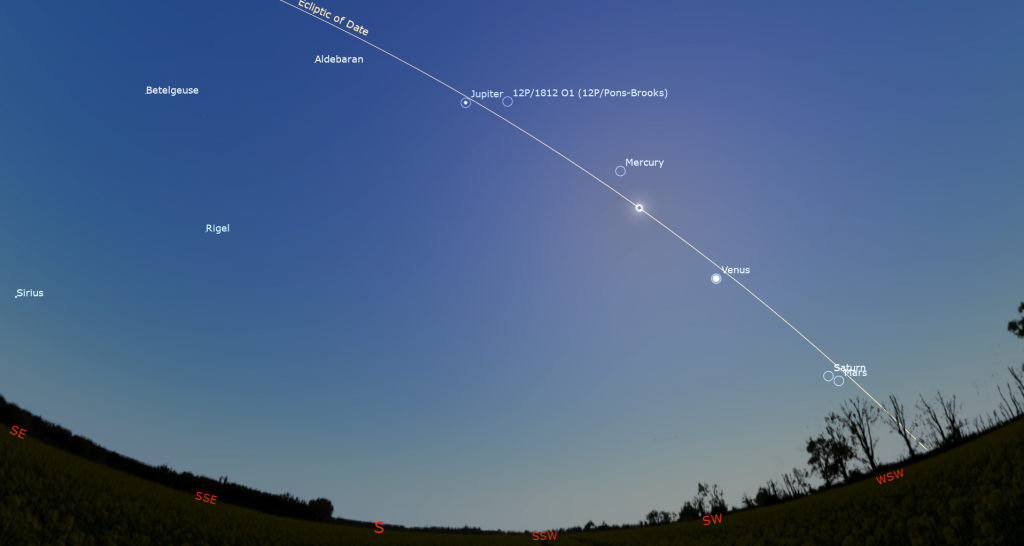
As a bonus, the periodic comet 12P/Pons-Brooks will be positioned a palm’s width to Jupiter’s right (or celestial WNW). It might be glimpsed in unfiltered binoculars during totality only, but be very careful to put filters back on before the exposed sun returns. You can also look for reddish sunset light in every direction around you – and the diamond ring and Baily’s Beads effects caused by sunlight sneaking past the moon’s uneven limb just before and just after totality.
The rest of the eclipse will unwind in reverse. Many of the same phenomena will occur – but you’ll be too busy celebrating to care that much!
While a partial eclipse shape can be seen through thin cloud, clear skies are extremely important for enjoying totality during a solar eclipse. Eclipses are not like horseshoes or curling – close isn’t good enough! Be sure to check your local forecast the days and hours ahead, and be prepared to drive along the track of totality to reach clear skies. Ensure that you don’t veer too far south or north, though – and leave the track. Remember that well-attended eclipses will put a strain on roads and on cell service. Consider downloading offline maps for your phone, and bring snacks and water for the long wait to leave the eclipse zone.

Imaging a total eclipse is popular – but unless you are 100% confident in your equipment, batteries, and game plan, watch the event and save imaging for the next eclipse. There’s nothing like seeing it with your own eyes! Wishing everyone clear skies!
The Moon
Let’s look at what the moon will be up to before it meets the sun. This week, our natural satellite will only be visible low in the southern half of the sky from the dark, wee hours of morning and on into daytime. That will leave the evening sky worldwide darker for viewing spring galaxies and other sights.
When the waning gibbous moon rises just before 3 am local time on Monday morning, it will be perched above the spout of Sagittarius’ Teapot asterism and washing out the soon-to-be summer Milky Way in the background. The moon will reach its third quarter phase on Monday at 11:15 pm EDT or 8:15 pm PDT, which converts to 03:15 Greenwich Mean Time on Tuesday.
The moon will wane in phase and rise almost an hour later each morning – leaving the Archer’s stars for next-door Capricornus (the Sea-Goat) on Wednesday and Thursday. By then the sky will be brightening when the moon clears the southeastern rooftops.
The old waning moon’s pretty crescent will shine above the southeastern horizon on Friday morning. Before the sky brightens too much, sharp-eyed observers with an unobstructed view can see the planets Mars and Saturn arrayed a generous fist’s diameter to the moon’s left (or celestial east-northeast). The two planets will appear about the same brightness and cozy enough to share the view in binoculars. Much brighter Venus will rise to their lower left around 6:30 am local time, with faint Neptune invisible near it. Observers in westerly time zones will see the moon a bit closer to the planets. Be sure to turn all optics away from the east before the sun rises.
The old moon’s visit with the morning planets will continue on Saturday. After 24 hours of motion, the moon will shine directly below Saturn, with Mars positioned at their upper right. Once the moon rises around 6 am local time, all three objects will fit within binoculars’ field of view – but turn all optics away before the sun rises. Observers in most of Antarctica, the Kerguelen Islands, and Marion Island can see the moon cross in front of (or occult) Saturn around 09:30 GMT.
Finally, before sunrise on Sunday, April 7, skywatchers located along tropical latitudes can try to see the extremely thin crescent of the old moon poised two finger widths to the upper right (or celestial southwest) of the bright planet Venus. Look just above the eastern horizon as the sky is brightening. The very faint planet Neptune will be located about the same distance to the moon’s upper right. The trio will be cozy enough to share the view in binoculars, but the dawn twilight will make seeing Neptune very difficult. Hours earlier the moon will have occulted Neptune for residents of the South Atlantic Ocean region. For observers in a zone extending from the eastern South Pacific Ocean, across Central America and the eastern portions of the USA and Canada, and over to the North Atlantic Ocean, the moon will pass in front of Venus in broad daylight during mid-day. Due to the nearby sun, only observers experienced in safe solar viewing should make an attempt to see that occultation.
Comet Pons-Brooks
I’ve been updating everyone about a periodic comet named 12P/Pons-Brooks that is visible in the northwestern sky in early evening. The comet has so-far reached about magnitude 4.5, which is within reach of a small backyard telescope or good binoculars under dark skies – and possibly unaided eyes under this week’s moonless sky. The comet should continue to grow a bit brighter as it draws closer to the sun and warms further in later April. You may have heard this comet referred to as the “Devil Comet”, a silly clickbait name that is a leftover from last fall when the comet sprouted two jets of gas that made it resemble a horned head or the Millennium Falcon. It no longer looks that way.
For observers in mid-northern latitudes on Earth, the comet will continue to be found descending the western sky after dusk every night. The best combination of sky darkness and the comet’s height will be around 8:45 pm in your local time zone. Visually, expect to see a faint, fuzzy smudge that may look greenish in photographs and larger telescopes. Its faint tail, best seen in binoculars and long exposure photos, will extend upwards. The comet will drop below the treetops by about 9:30 pm, so start looking as soon as the sky darkens.
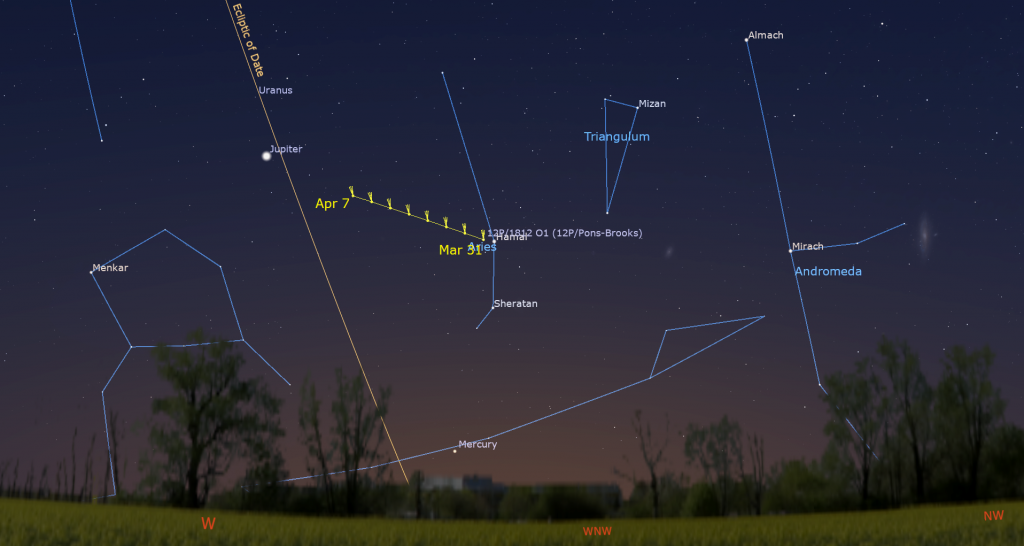
This week, Comet Pons-Brooks will continue to travel through Aries (the Ram) in the direction of Jupiter – from lower right-to-upper left in the sky. Tonight (Sunday) it will be positioned just to the left (or celestial southeast) of the bright star named Hamal – and therefore extremely easy to find! Each night after that the comet will slide away from Hamal and toward Jupiter, landing midway between them on Friday. Let me know if you see it!
The Planets
The very bright “star” shining above the western horizon after sunset every night is Jupiter. We have another week or so to view the giant planet after dusk while it shines reasonably high in a dark sky surrounded by the stars of Aries (the Ram). But its inexorable drop sunward each night due to Earth’s motion around the sun will soon see Jupiter embedded in twilight, where unaided eyes and binoculars will work the best. Watch for the tightly packed, but bright Pleiades star cluster twinkling a generous fist’s diameter above Jupiter. Binoculars will show those Seven Sisters well, too. Jupiter will set at about 10:30 pm local time.
Look for Jupiter’s four largest Galilean moons lined up beside the planet. Named Io, Europa, Ganymede, and Callisto in order of their orbital distance from Jupiter, those moons complete orbits of the planet every 1.7, 3.6, 7.2, and 16.7 days, respectively. If you see fewer than four moons, then one or more of them is crossing in front of or behind Jupiter, or hiding in Jupiter’s dark shadow – or two of the moons are very close together or occulting one another. The four moons and Jupiter will spread out like beads on a necklace on Friday evening and the moons will gather to one side of Jupiter on Saturday evening. As I mentioned above, the window is still open to see the passage of periodic comet 12P/Pons-Brooks, which will be sliding towards Jupiter from the lower right each night.
The blue-green speck of Uranus will be located just two thumb widths above Jupiter, trailing about 15 minutes behind it on the ecliptic. The magnitude 5.8 planet will be quite easy to see in binoculars and backyard telescopes until about 9 pm. The two planets are close enough for them to share the view in binoculars – with Uranus at the top and Jupiter at the bottom. Uranus will also be positioned less than two finger widths to the lower left of a medium-bright star named Botein (or δ Arietis). Since Jupiter is closer to the sun than Uranus, its faster motion will outrace Uranus every night until they kiss in twilight on April 20. This week their separation will shrink from 3.4° to 2.3°.
For the first few days this week, you might spot Mercury shining just above the west-northwestern horizon. Mercury will drop a bit lower each night as it heads to its next meeting with the sun.
Once Jupiter and Uranus set, the night sky will be devoid of planets until reddish Mars rises in the east around 5:45 am local time. Watch for creamy-yellow Saturn, about equally as bright, shining a few finger widths to Mars’ lower left. They’ll kiss at conjunction next week. The severely tilted morning ecliptic will keep the planets low in a brightening sky, but observers living closer to the tropics, where the ecliptic will stand upright, will have a much easier view.

Venus is swinging closer to the sun every morning, causing the brilliant planet to shift down and to the left compared to any nearly trees or buildings near it. Venus will meet the sun at solar conjunction in early June. For now, at mid-northern latitudes Venus will rise at about 6:30 am local time, but you may need to walk around to position the planet between trees or buildings.
Galaxy Season
It’s a prime week to view galaxies and Messier Objects without any moonlight to contend with. These Skylights are already long enough, so I invite you to read the guided tour of galaxies I posted last April here. The stars will be same this week.
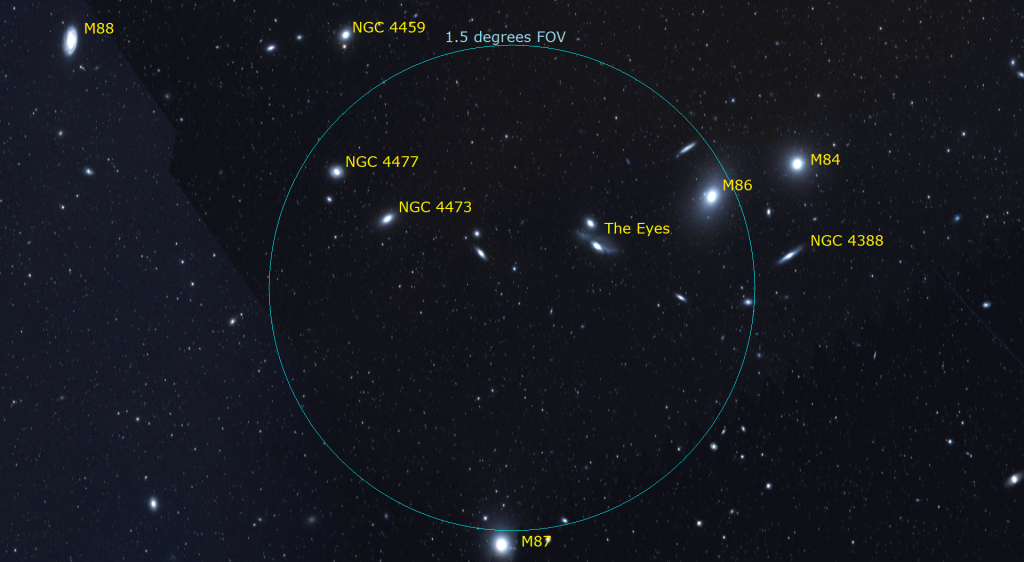
Public Astronomy-Themed Events
Every Monday evening, York University’s Allan I. Carswell Observatory runs an online star party – broadcasting views from four telescopes/cameras, answering viewer questions, and taking requests! Details are here. They host in-person viewing on the first clear Wednesday night each month. Other Wednesdays they stream views online via the observatory YouTube channel. Details are here.
On Wednesday evening, April 3 at 7:30 pm EDT, the RASC Toronto Centre will host their free, public, in-person monthly Recreational Astronomy Night Meeting in the Gemini East Room at the Ontario Science Centre. The meeting will also be live streamed at https://www.youtube.com/rasctoronto/live. Talks include The Sky This Month, a tour of RASC’s Carr Observatory, and Jewish Astronomy and the Hebrew Calendar. Details are here.
On Saturday, April 6 from 10 am to noon, you can try out Solar Observing at the Ontario Science Centre! If it’s sunny, members of the RASC Toronto Centre will be setting up outside on the Teluscape in front of the main doors. They’ll have an array of special equipment designed to view the Sun safely. This is free to the public, but parking and admission fees inside the Science Centre will still apply. Check the RASC Toronto Centre website or their Facebook page for the Go or No-Go notification.
On Friday, April 5 from 9 to 11 pm EDT, the in-person Astronomy Speakers Night program at the David Dunlap Observatory in Richmond Hill, Ontario will focus on the upcoming April 8 total solar eclipse.After the presentation, participants will tour the observatory and see a demonstration of the 74” telescope pointed to an interesting celestial object for the visitors to view (weather permitting). More information is here and the registration link is at ActiveRH.
Keep your eyes on the skies! I love getting questions and requests. Send me some!